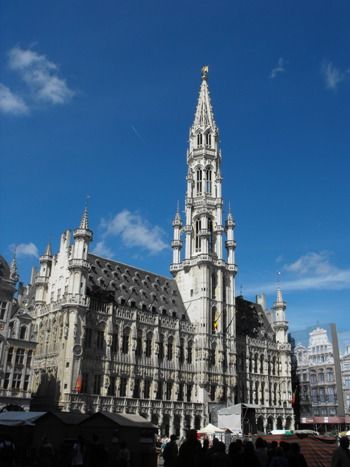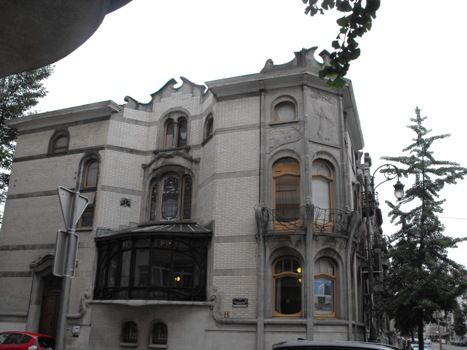
Two weeks ago, I went for a short trip to the Belgian capital of Brussels. Even though it's quite close to home (less than 3 hours by train), it was still very different (language, architecture, culture etc), so I really felt like I was away from everyday life and I totally enjoyed it!
Day 1: arrived from The Netherlands. Met up with a friend of mine who lives in Brussels. Didn't take many pictures that day, because we were to busy talking!

Day 2: I first went to the touristic hart of Brussels, the Grand Place, with the famous City Hall (see above). The town hall is a beautiful example of Brabantine Gothic from the 14th century.
Then I went and visited the Cathedral of St.Michael and St.Gudula, a beautiful Gothic church from the 13th century.

Brussels city centre has a Lower Town and an Upper Town, with the Lower Town being the oldest part with the Grand Place and the Upper Town having mainly the Royal buildings and the 19th century extensions. Between the two there's this lovely little park on the so called Mont des Arts (hill of the arts). You can see the spire of the City Hall in the middle.

At the turn of the century (1890-1910), Brussels was at the heart of the Art Nouveau movement and there are many beautiful buildings in this architectural style in the city. One of the more flamboyant ones is the former building of the department store Old England (1899)
Day 3: Because for some silly reason many museums and attractions are closed on Mondays in Brussels, I decided to visit the city of Leuven, a university city some 30 km from Brussels. Leuven houses the oldest university of the Low Countries (current Netherlands + Belgium + Luxembourg)

Grand Place of Leuven with (another) Gothic town hall and a large Medieval church. I actually thought Leuven was a prettier city than Brussels overall, but aren't smaller cities often prettier compared to large ones?

A cute street in the Beguinage, a former community of unmarried, semi-religious women. Most of the houses and other buildings date from the 16th century. The remaining beguinages in Flanders are a UNESCO World Heritage site.

St. Peter's church, the main church of Leuven. It's facade looks a bit sad and unfinished, but the church doesn't have large towers because the ground stability in Leuven couldn't carry that. There was some pretty amazing Medieval artwork inside the church.

The Library and Library Tower of Leuven. Even though the facade might indicate otherwise, the Library is actually a relatively recent building, from 1921. In WWI, the Germans burned down the original 17th century library (and some 80.000 books, some of them centuries old!) The current building was a gift from the American people after hearing about this needless act of violence. Very, very sadly, in 1940, the occupying German forces of WWII again largely destroyed the library and it's contents....
Day 4: Place Royale, the main city square of the Upper Town, with a large statue of the Medieval count Godfrey of Bouillon. (You can see the spire of the Town Hall again right from the statue)

I visited several two museums this day, one of which was the Fin-de-Siécle museum, displaying art from the end of the 19th/beginning of the 20th century.

One of the art movements of that time period was Social Realism and this amazing painting (The Chalk Sellers (1882) by León Frederic) is an example of the movement, depicting laborers at their everyday work.

Brussels, as you might know, is not only the capital of Belgium, but also somewhat of a capital of Europe, with all the important European institutions based here. This is the building of the European Parliament (I should have visited Brussels one week earlier actually, because there were European elections just before my trip and now I have the idea I know much more about how the European Union works *facepalm*)
Day 5: Cinquantenaire Park is a park in Brussels laid out to celebrate Belgium's 50th anniversary in 1880. The centrepiece is this triumphal arc with an arcade.

The buildings in the arcade house museums, the Military Museum, the Art Museum and Autoworld.

I visited the Military Museum, where there was a new exhibition about WWI. This was a rebuild 'American shop', a shop from the Commision for Relief in Belgium, a US organization which distributed food in occupied and starved Belgium during WWI.

Walking through the park, I suddenly heard screeching above me. As I looked around, I spotted this parakeet in a tree. These Rose-ringed parakeets are feral and come from birds which were held as pets and either escaped or were set free.

As I said before, Brussels has a lot of Art Nouveau architecture. To end my trip, I walked around in an area with a lot of these houses, among them this beautiful Hannon House from 1903. Art Nouveau is actually quite a 'new' architectural style for me, I never have seen much of it before, but I really like it and will look out for it in further trips (and have already discovered some Art Nouveau houses in my own city as well!)

You know, I'm usually equally proud of my German and Dutch heritage, but what is with the Germans and their penchant for burning books?????? And destroying artwork? GRRRRRRRRRRRRRRR. Maybe that's why my ancestors came to America.
ReplyDeleteAnyway, glad you had a nice trip! Your photos are lovely.
I think every country has it's black pages in history, but you're right, traveling through Europe it's sometimes hard not to get just a little bit angry at the Germans....
DeleteWow, this post is so interesting! I don't know anything about architecture, and there's a good chance I'll never be able to travel to Brussels, so thank you for sharing this!
ReplyDeleteThank you so much! Really glad to hear you liked reading this as I love sharing my holiday pictures!
Delete